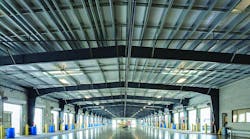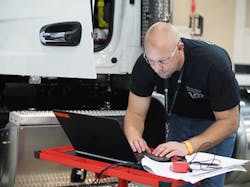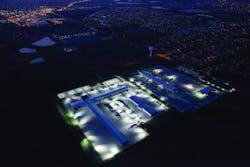As heavy-duty trucks become ever more complex, the work of technicians has evolved. Where once a mechanic simply lifted the hood and made the repair, today a technician runs diagnostics and consults a computer before replacing any components.
The operations of a typical heavy-duty truck could require input from up to 10 computers. And those computers generate a lot of data concerning vehicle health and wellness, including over 38,000 fault codes.
A connected shop is more important than ever—and for that simple reason, one of the first things technicians reach for these days is their computer and/or diagnostics tools. That salient fact is altering not only the maintenance process but also the overall shop environment.
“Digital shops are a requirement today [because] the information stream available [from the truck] requires technology to be able to distribute the right information to the right people,” explains Rick Tapp, maintenance manager for Paccar Leasing (PacLease).
The key is having technology that captures such information in a uniform way and allows it to be accessed as needed. “A few of these high-level processes would include scheduling [repair] manpower and customers, matching the technician skill set with the correct task, payroll, parts inventories and asset tracking, plus the cost and repair process at the fleet and unit level,” Tapp says.
“Each of these major groups has a similar list of subgroups as well,” he adds. “For instance, parts inventories would further include electronic ordering and restocking by usage requirement all the way down to seasonal usage, managing parts obsolescence, counting and costs, and reassigning costs when parts are used.”
Tapp also believes this is something of a natural evolution in the truck maintenance realm, mirroring the advances experienced in other business technology arenas.
“Email sent fax machines to the scrap heap, and texting via mobile devices is rapidly replacing email,” he points out. “Manual processes are only successful today in the smallest of fleets.”
Yet, does this digital shift make truck maintenance easier? In the past, technicians had to rely on experience and their five senses to intuitively guide their repair protocols. Today, though, the trucks themselves spit out a host of data parameters and often while the truck is in motion. In the case of remote diagnostics, technicians are forced to start prepping for a repair before the vehicle has arrived at the shop.
Channeling data
“It’s not making maintenance easier, but it is making it more accurate, better and faster, and repairs are [performed] correctly the first time because of all the information available,” Tapp notes.
Gregg Mangione, senior vice president of maintenance for Penske Truck Leasing, agrees—to a degree.
Penske is trying to take all the maintenance data being generated and route it to a tablet computer in the technician’s hand. The hope is that this will reduce the amount of time the company’s techs need to spend away from the truck they are fixing.
“We looked at time and motion studies concerning trips to the toolbox and also trips to the PC and to a central printer,” Mangione explains. “We found 40% to 50% of their time was spent moving back and forth from PCs or to go to a printer. Why not use a tablet so all the fault codes and supporting information is right there?”
Penske is introducing driver vehicle inspection report kiosks gradually throughout its nearly 1,000 service locations to help clean up data flow on the front end of the repair process. The kiosks allow information to be digitized right from the get-go, says Mangione, with drivers using an icon-driven order board to report issues. “This allows for better, more detailed information to be transferred faster to the technician while allowing it to be archived digitally for easier reference,” he explains.
The company is also trying to create a digital schedule that displays a column for each technician and the jobs they are working on. “This allows them to visually track the progress of everyone’s work and help spot problems sooner via color codes,” Mangione notes.
More skills
George Bowers, director of maintenance operations for Ryder System, says that a way to generate more complete digital profiles of equipment is to create vehicle health check forms at the time of service.
“If the vehicle is in our shop, we’re trying to look forward to see if it’s about to have an issue so we can get ahead of it in terms of downtime,” he explains. “This is critical as multiple systems on today’s trucks interact with one another.”
It’s made more complicated as individual truck manufacturers and component suppliers often provide their own specific diagnostic software support packages and fault code trees for managing repairs. But that data can also make a technician’s job easier in the future as shops record and catalog data for future reference.
Joe Puff, vice president of truck technology and maintenance at NationaLease, points out that such tactics don’t lessen the knowledge base or skill sets the truck technician needs.
“The last 10 years we’ve seen truck technology change at hyperspeed, and it’s still changing at that pace,” he says. “Back in my day, there wasn’t anything really electronic on a truck other than the radio. Today, if you are a good, experienced technician, that’s the equivalent of a bachelor’s degree in terms of knowledge acquired. To be a complete bumper-to-bumper technician today is the equivalent of a master’s degree or Ph.D. That’s the equivalency in terms of schooling and constant learning.
“In some ways, rebuilding an engine is the easy part; the challenge now is successfully digesting all the diagnostic data, integrating it with the truck, and making it all tick smoothly,” Puff stresses.
That’s also leading to more segmentation of repair work. “With the continued evolution to more electronics and more computers and programming, the divide in work skills continues to grow,” PacLease’s Tapp says. “Today’s shops tend to have a group of technicians who are comfortable and proficient with the hands-on wrench turning. They do not want to devote the time and effort to stay abreast of the required skills to deal with computers but do want to learn about new hard parts,” he explains.
“Yet another group of techs in the same shop only want to work on the latest equipment equipped with the newest technology. They are interested in the computerized side of trucks,” Tapp notes.
“There is a necessity for both types of technicians [as trucks] will always need brake jobs, clutch jobs, and other maintenance services. The fault codes will help a servicing technician identify issues without having to use a computer and be able to divert the units with codes for further follow-up to the computer tech group.”
Digital detectives
The highly computerized nature of today’s trucks isn’t just changing the skill sets required by maintenance technicians; it’s also altering their problem-solving perspective as well.
To Jason Swann, a nearly 17-year veteran technician at the Rush Truck Center (RTC) in Dallas, TX, it means much more out-of-the-box thinking is needed.
“It’s not always follow step one, two and three on the [diagnostic repair tree] and the fault is fixed,” he explains. “Sometimes you shouldn’t even be at step three because that is leading you the wrong way; you don’t want to go down the rabbit hole with a repair.”
As an example, he tells of a situation he once faced with three trucks with antilock braking system (ABS) faults that effectively shut them down. “I had an engineer from the [brake system] supplier with me, and after a full day working on them, we still could not fix them,” Swann says.
So, he stepped back to take a fresh look at the big picture—not just at the truck but its daily operating characteristics. “The problem wasn’t in the [brake] system, and it wasn’t on the truck,” Swann explains.
As it turned out, the fleet in question offered its drivers a bonus on fuel economy and idle reduction fuel savings. Drivers would turn their vehicles on and off frequently—even if they had to move them just two feet.
Those frequent and fast ignition cycles created a problem. “They didn’t allow the ABS to fully cycle. All the drivers needed to do was allow the ABS system to fully cycle before shutting the truck off,” he notes. “That would stop triggering all the warning lights.”
Swann adds that engineers in the laboratory designing such technology probably never even experienced this type of situation. “Out here in the real world, very different things happen,” he says, noting that technicians are often like front-line infantry in the truck repair world in terms of the time pressures and unusual situations they face.
“An engineer in a lab can experiment with different things, swap out components, and have time to do all of that,” Swann points out. “In my world on the shop floor, time is critical, and the customer must approve every component you replace. If a solution you thought would work doesn’t work, that can make things even more difficult.”
Building smarter shops
It’s all well and good to discuss the increasingly virtual nature of truck maintenance, but repairs still involve many physical entities—from the technician and vehicle to the shop within which both will reside. That’s why the high-tech needs of today’s truck environment need to be incorporated into maintenance facility designs from the get-go, explains Bill Plesich, project executive with Renier Construction, a 35-year-old firm based in Columbus, OH.
“You really need to make sure you involve all the people who will work in a maintenance facility in the beginning when you design it, especially the IT [information technology] people,” he says.
Things like how much building space will be devoted to computer servers, electric wiring needs, wireless network layout, and other IT functions need to be established at the front end, Plesich notes.
“You want to design a shop that is going to last a long time yet be as efficient as possible in terms of energy consumption,” he explains.
Plesich himself has directed the construction of 16 maintenance facilities and has the following tips to share from his experience:
◗ Involve as many people in the design as early as possible, i.e., the owners, IT, technicians, drivers, etc., for input. The smoothest and most efficient projects involved everyone in design early on.
◗ Aim for 20-year life spans of building and use materials: ceramic tiles on floors, thicker 8- to 10-ft.-high “block wall” sections to better absorb abuse, piano hinges for the doors, and concrete paving outside instead of asphalt. “Asphalt has a 10- to 15-year life span at best, while concrete will last 20 years or longer,” Plesich says. “Ripping out and repaving asphalt lots is a huge disruption.”
◗ Expect to spend $1 million to $2 million to build a solid, long-lasting shop.
◗ Keep expansion in mind when building a shop. “Try to think a few steps ahead in case you decide to add more bays, fuel islands, and especially diesel exhaust fluid areas,” Plesich notes. “Make sure you keep up with regulatory changes as well.”
◗ To save money, think thermal efficiency. That means installing skylights for more natural lighting and using light emitting diode (LED) lamps to reduce energy consumption. “We have sensors now that actually adjust the lighting based on the brightness of the day,” he says. “LEDs last longer with less maintenance.”
◗ Don’t forget the human factors in the design. That includes window heights, internal temperatures within the shop, the planned location of toolboxes versus where the actual work will be completed, plus breakroom driver lounge comforts.
◗ Security must be a design fundamental—from fencing and parking lot lighting to shop entrance/exit areas. “In some of the shops we’ve built, we put turnstiles at the entrance/exit areas so no large items like boxes can be brought in,” Plesich notes. “It’s not a safe world out there.”





